How the hood in the garage is arranged: popular schemes and technology for proper arrangement
Garage - the room is relatively small, but its arrangement should not be treated carelessly. It should protect the vehicle from external influences: bad weather, theft, etc. But inside, you need to create a microclimate that is useful to people and technology. This is easy to achieve if the hood in the garage is arranged correctly.
We will tell you how to better organize ventilation in the garage space, how to strengthen it if necessary. The article describes all types of systems tested in practice, the specificity of their device is analyzed. Based on our recommendations, exhaust air removal will no longer be a problem.
The content of the article:
Why ventilate the garage?
Of course, a garage is a technical and not a residential facility, although some car owners may not agree with this statement. If a car enthusiast spends a considerable part of his personal time in the garage, and even uses the basement or the garage itself to store food supplies, all the more you should be concerned about the problem of proper air exchange in such a specific room.
For starters, there is a high concentration of exhaust gases, fuel vapors and other process fluids. Even a short stay in such an atmosphere is extremely harmful for a person.
The second problem associated with improper ventilation of the garage is excess moisture. Water vapor accumulates indoors and condenses on various surfaces, including the car. As a result, the risk of occurrence and the rate of corrosion processes increases sharply, in other words, the vehicle rusts.
Often in garages or cellars arranged under them, vegetables, canned goods, other products or things that could not be found in a house or apartment are stored. Contact with moisture, as well as exposure to technical fumes will not bring all these objects any benefit. And you can simply solve the problem, just take care of effective ventilation.
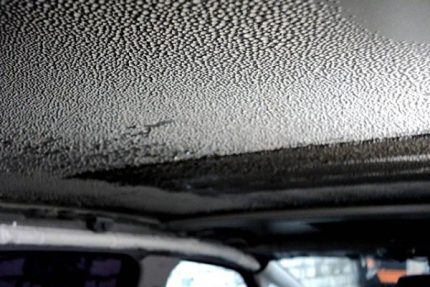
What you need to know about room ventilation
Everyone who has at least once encountered the problem of indoor air exchange knows that they distinguish between a natural, forced and combined ventilation system. The first option is simple: it is based on the difference in air temperature inside and out.
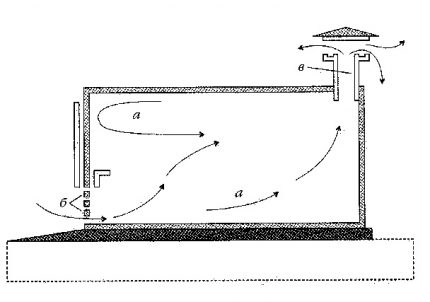
As you know, warm air rises, and cold air goes down. The idea is that cool air masses enter the room from the street, rise up and naturally leave through the exhaust outlet. At the same time, they must be replaced by new streams of fresh air that flows outside.
In the garage, such ventilation is easy to organize. To do this, it is necessary to provide sufficiently wide openings for the inflow and exhaust of air, but the temperature difference inside and outside the room will also be of great importance.
There are no problems with this condition in the winter, but in summer, when the heat is almost the same everywhere, the efficiency of natural ventilation decreases dramatically.
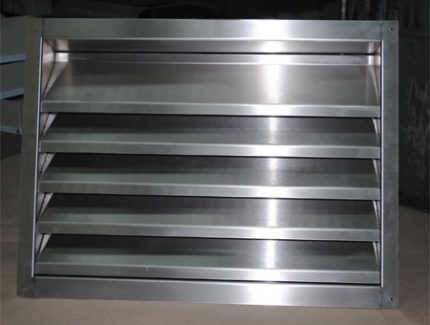
An alternative in this situation is forced ventilation, i.e. using additional funds. Special fans are installed in the supply and exhaust openings, which, depending on the purpose, blow air into the room or remove it.
But to put two devices at the same time for one small garage is not always reasonable and justified from an economic point of view. It is more profitable to use a combined ventilation system, for which only one device is needed.
For example, a supply fan is installed, it pumps in fresh air, and the exhaust air masses are forced out through the exhaust outlet.
In garages, an exhaust system is considered more acceptable. Install a fan that effectively removes air saturated with harmful fumes and excess moisture. Fresh air masses will enter the room naturally through the supply side of the system.
How to organize natural ventilation?
To ensure proper natural ventilation of the garage, you must remember a number of basic rules:
- An air inlet is placed below, about 10 cm above the floor.
- An exhaust hole is made at the top, almost under the ceiling or even directly in the ceiling.
- The best option for placing these holes is diagonally, i.e.if the inflow is carried out in the lower front corner, then the hood must be put in the upper far corner.
- The size of the holes must be correctly calculated in order to ensure sufficiently intense air exchange.
- The inlet must always be two to three times larger than the dimensions of the hood.
Well, if the ventilation was calculated and created during the construction of the garage. If this moment was missed, you will have to perform a number of relatively simple installation work. It also happens that ventilation is provided, but does not give the desired results. In this case, you will need to improve the system, for example, by installing an exhaust fan.
If you consider the natural ventilation operation ineffective, then there is the opportunity to upgrade the system, for example, by increasing the height of the exhaust pipe:
Upon completion of the preparatory process, we proceed directly to the assembly of the system and to fixing the high pipe with stretch marks:
How to calculate everything correctly?
Ventilation calculations in many cases require special knowledge and the use of complex techniques. If there is a desire and allows the wallet, the creation of the project can be ordered from specialists. Fortunately, a garage is a small room with a simple configuration.
The dimensions of the ventilation holes are calculated by the formula:
Pcut= Ngar×15
Wherein:
- Pcut - cross-sectional area of the ventilation hole;
- Pgar - garage area;
- 15 - coefficient reflecting the size of the ventilation hole per unit area of the room.
Those. you need to multiply the area of the garage by 15 mm. According to this simplified technique for a garage of 24 square meters. m. (6 * 4) you will need a supply hole with a diameter of 360 mm. These calculations are very arbitrary, since the technique does not take into account the height of the room and its other features.
In practice, these indicators can vary. For the above garage area of 24 square meters. m. in one particular case, two 150 mm pipes on the inflow and one such pipe on the exhaust were successfully used.
To increase the efficiency of natural ventilation, you can use additional tools:
- Deflector - a special cap, which is installed on the edge of the vertical section of the exhaust pipe to create a rarefied atmosphere inside the structure and accelerate the movement of air masses.
- The diffuser is a weather vane for the outer part of the supply pipe; wind pressure is used for its operation.
- An ordinary incandescent lamp - it is installed inside the exhaust pipe and heats the air flow, accelerating its movement.
These simple devices can significantly improve the quality of ventilation in the garage.
With general principles calculating the power of ventilation systems The following article, which we recommend that you familiarize yourself with, will familiarize you.
How to correctly perform the installation?
To organize the proper ventilation of the garage, you will need to make at least two holes: for the influx of fresh air, as well as for the output of streams saturated with harmful fumes and excess moisture. The inlet is made in the lower part of the outer wall, about 10-15 cm from the floor.
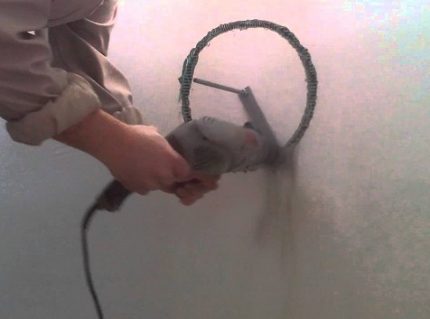
Thick walls of residential premises are drilled using special equipment, but for garages such difficulties are not needed. Most often, drilling a hole of a suitable diameter is performed using a hammer drill.
After that, a pipe or pipes for inflow are inserted into the hole and their position is fixed. To seal the gaps between the pipe and the wall material, use foam. The outside of the hole should be protected with a special grille or diffuser.
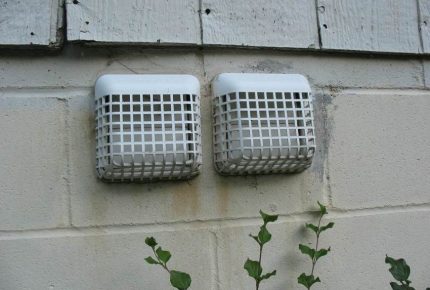
The cross section of the ventilation duct can be made not only round, but also square or rectangular. For installation you will need pipes of the appropriate configuration. Usually for garage ventilation use ventilation pipes with a round section.
This is the cheapest and most convenient option, in addition, they create minimal resistance to air flow. Metal pipes and plastic constructions are suitable for ventilation.
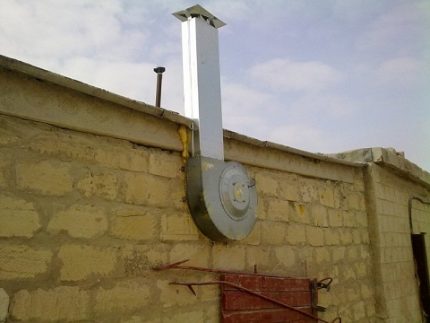
The hood is made under the ceiling. The pipe is led horizontally through the wall and then a vertical piece is mounted. It should be long enough.
An hood is considered optimal, which rises above the roof by at least 50 cm. A hood-deflector is often installed from above. The inside of both the supply and exhaust openings should be covered with a decorative grille.
Combined and forced ventilation
As noted above, the natural ventilation of the garage is effective only under certain environmental conditions, i.e. with a sufficient difference in temperature inside and outside. The use of forced ventilation eliminates this type of problem.
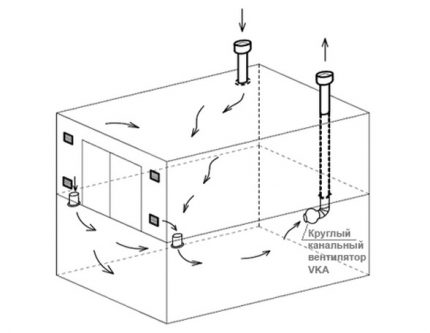
Effective air removal in the garage is more than relevant, since the level of pollution here is much higher than in residential premises. Therefore, the owners of garages prefer the exhaust version of combined ventilation. Implementing a project of this type is not so difficult.
To do this, you need to purchase an exhaust fan and install it at the entrance to the pipe. If such a pipe is missing, it must be installed. This is done in approximately the same way as when installing natural ventilation. Calculations, materials and tools will be needed the same, calculations are carried out in a similar way, but there are several differences.
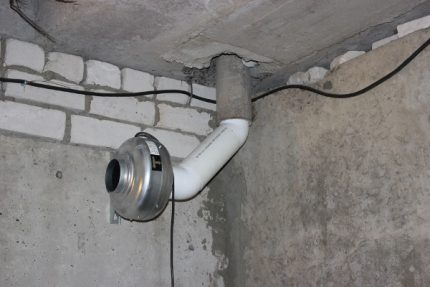
With combined ventilation, it is not necessary to install the hood strictly diagonally from the air inlet, although this position is desirable. You can choose another place, both for the supply and exhaust vents. But the first one still needs to be placed below, and the second - at the top.
Another important point is the presence of furniture and other objects in the air flow path. This is a common mistake when designing ventilation. The fewer such obstacles, the better the air exchange will be. An exhaust fan should be installed in the upper pipe.
This can be a channel model, which is installed inside the pipe, or an invoice option, such devices are mounted directly on the wall. After that, the fan should be connected to the power supply.
To improve the functioning of such a hood, it is possible to provide the fan with additional automatic control modules. For example, a timer that will turn the device on and off at a specific time.
This will slightly reduce energy costs, as well as provide ventilation for the garage, even in the absence of its owner. If the garage already has natural ventilation, but it does not work efficiently enough, the best solution would be to install an exhaust fan in a ready-made duct.
If in the winter period natural ventilation is carried out quite well, then the fan can be used only in the summer.
Forced ventilation involves the installation of both the supply and exhaust fans in the corresponding openings. In ordinary garages, such systems are usually not used, since the problem is solved with the help of simpler options: a natural or combined system.
Making forced ventilation in the garage makes sense only in cases where you just can not do without it. For example, for a garage located underground, forced ventilation is the only option. It happens that in the garage it is planned to carry out paintwork or other work in which good air exchange is of particular importance. Here forced ventilation will come in handy.
Those who wish to equip the garage with an effective exhaust system, required to remove toxic substances generated during welding and painting, it will be useful to familiarize yourself with the following photo selection. It represents the process of constructing a hood with corrugated tube sliding sleeve:
Cellar and viewing hole
Above, the option of venting a conventional garage was considered. If inside there is a basement and / or viewing hole, these facilities should be taken care of separately. In the case of the basement, you will have to arrange a separate ventilation duct. This is necessary, since much more moisture accumulates at the bottom than at the top of the room.
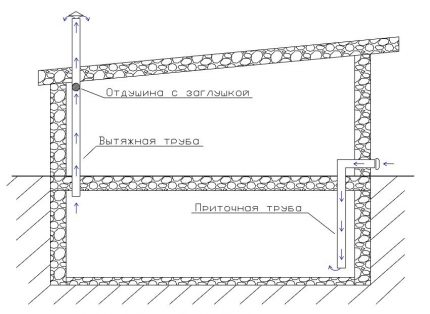
If there is no ventilation, this moisture will enter the garage and cause harm to the vehicle stored in it. Ventilation, which is arranged in the garage, even when using forced methods of inflow and removal of air, usually can not provide a sufficiently intense exchange of air masses.
For efficient basement ventilation two holes should be made: supply and exhaust. It is recommended that the air in the southern part of the cellar be secured, and the air outflow from the north.
A supply pipe is usually introduced into the cellar through the garage floor and lowered as low as possible. The hood is arranged in the opposite corner, this pipe is led up and out through the floor of the garage. As with the ventilation device in the garage, the cross section of the inlet openings should be two to three times larger than the dimensions of the hood.

The greater the difference in height between the edge of the feed and the hood, the more efficient the ventilation of the cellar will be. A difference of three meters or more is considered optimal. To increase the difference, the vertical part of the exhaust pipe, which is displayed on the street, you just need to make it higher. You can also install a deflector or a protective cap here.
Sometimes the installation of the supply pipe for some reason is not possible. In this case, it is recommended to leave the hatch slightly ajar so that the fresh air entering the garage moves into the basement.The lack of fresh air will make all efforts to organize an efficient extract from the cellar in the garage useless.
If the garage is heated, condensed moisture may appear on the chimney in winter. To prevent icing of the pipe, a special condensate cup is installed.
For an unheated garage, this measure is not required. In winter, food and items stored in the cellar should be placed no closer than half a meter from the air inlet, otherwise they may freeze.
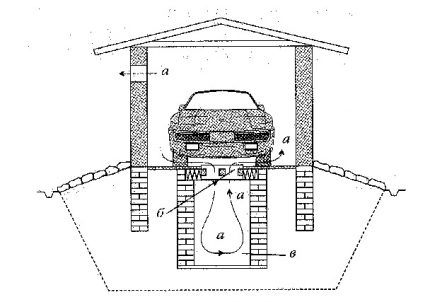
A viewing pit is a small object in volume, therefore, they usually do not provide separate ventilation for it. Nevertheless, it is worth taking care of a good air flow. To do this, on the side of the inspection pit that faces the supply air vent of the garage, you need to make slots of about 10-15 cm. You can open the two sides of the pit in a similar way.
From the side of the hood, you also need to make such a gap, but it should be twice as narrow. For safety's sake, you can cover these slots with boards in some places. When installing the car, make sure that it does not overlap the exhaust gap, as this is dangerous for the vehicle.
The rules and options for the ventilation device in the garage for independent masters are set out in the next article.
Conclusions and useful video on the topic
Video # 1. Interesting and detailed information on the ventilation of a garage is described in this video:
Video # 2. This video demonstrates the operation of the exhaust duct fan:
Video # 3. Here you can see the experience of creating a homemade hood for a garage, made from improvised means:
Organizing a quality hood in the garage is not so difficult. You need to choose the right system and install it, or to improve an existing ventilation option. This will positively affect the condition of the car and the health of the owners of the garage.
Want to talk about how you made or upgraded ventilation in your own garage? Have useful information or have questions while reading the article? Please write comments and leave a photo on the topic in the block below.

 Inspection pit ventilation in a garage: specifics of arranging an air exchange system
Inspection pit ventilation in a garage: specifics of arranging an air exchange system  Basement ventilation in a private house: the best ways to arrange proper air exchange
Basement ventilation in a private house: the best ways to arrange proper air exchange 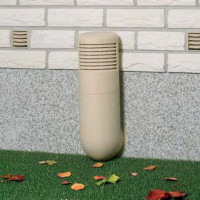 Ground floor ventilation: general arrangement technology + effective air exchange methods
Ground floor ventilation: general arrangement technology + effective air exchange methods 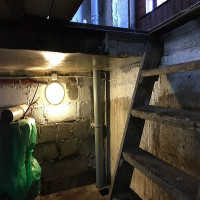 Ventilation of a vegetable pit in a garage: organization of air exchange in a garage vegetable store
Ventilation of a vegetable pit in a garage: organization of air exchange in a garage vegetable store  Do-it-yourself ventilation of the cellar in the garage: installation methods and procedures + useful tips for arranging
Do-it-yourself ventilation of the cellar in the garage: installation methods and procedures + useful tips for arranging 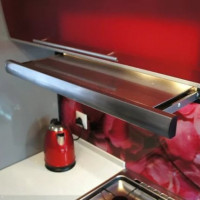 Hood without venting to ventilation: principle of operation, typical schemes and installation rules
Hood without venting to ventilation: principle of operation, typical schemes and installation rules  How much does it cost to connect gas to a private house: the price of organizing gas supply
How much does it cost to connect gas to a private house: the price of organizing gas supply  The best washing machines with dryer: model rating and customer tips
The best washing machines with dryer: model rating and customer tips  What is the color temperature of light and the nuances of choosing the temperature of the lamps to suit your needs
What is the color temperature of light and the nuances of choosing the temperature of the lamps to suit your needs  Replacement of a geyser in an apartment: replacement paperwork + basic norms and requirements
Replacement of a geyser in an apartment: replacement paperwork + basic norms and requirements
In the purchased garage, after putting things in order, the question arose of ensuring normal ventilation, since the old one was done poorly. I went for advice in a search, from the selected options I came across information here. Everything is written in a clear language, I read a lot of new things, plus what I knew before.
The attached videos came in handy, they explain what they read even better.
Now with the acquired knowledge, you can practice.
After the sale of the car, there was a garage, I decided to grow mushrooms in it, there was a question about ventilation. I made it from improvised means. I put an exhaust fan at the top, ordered a metal passage to it, to which I attached a plastic pipe for sewerage, inserted tees so that one of the outlets remained free, through which air comes out.Just there was no influx of fresh air, for which, it turns out, you need a hole in the lower part of the opposite wall. I'll try to use the above tips, I think everything will work out. Is it possible to apply ventilation calculation if ample ventilation is needed for my case?
Good afternoon, Oleg. No, another calculation plan is needed.
Each type of mushroom has its own requirements for air volume and should be repelled from it. For example, per ton of substrate, oyster mushroom needs 300 m3 / hour. Suppose the size of the garage is 6m x 4m, with a ceiling height of 3 meters. We calculate the cubic capacity 6m x 4m x 3m = 72m3.
We calculate how many times per hour there should be a replacement of air in the garage, suppose for two tons of substrate:
1.300 m3 / hour x 2 = 600 m3 / hour.
2. 600 m3 / hour: 7 2m3 = 8.33 times / hour, the air in the room should be completely renewed, rounded up to 9 times.
3. 9 * 72 m3 = 648 m3 / hour.
The power of your ventilation system should be calculated based on the exchange of 648 m3 / hour.
When designing, it is important to understand that for fungi (plants) the creation of a certain microclimate is required. Therefore, consider:
1. Power forced ventilation. Calculated by example.
2. The air flow rate created thereby. Too high can adversely affect the development of fungi.
3. The temperature of the outside air. A heat exchanger will be required to maintain the required temperature for rapid growth.
4. Humidification system.
All these parameters must be taken into account and linked together when designing a project. A competent approach will provide you with a thriving business.